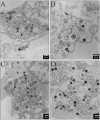A novel inhibitor of Chlamydophila pneumoniae protein kinase D (PknD) inhibits phosphorylation of CdsD and suppresses bacterial replication
- PMID: 19828035
- PMCID: PMC2765968
- DOI: 10.1186/1471-2180-9-218
A novel inhibitor of Chlamydophila pneumoniae protein kinase D (PknD) inhibits phosphorylation of CdsD and suppresses bacterial replication
Abstract
Background: We have shown previously that Chlamydophila pneumoniae contains a dual-specific Ser/Thr protein kinase that phosphorylates CdsD, a structural component of the type III secretion apparatus. To further study the role of PknD in growth and development we sought to identify a PknD inhibitor to determine whether PknD activity is required for replication.
Results: Using an in vitro kinase assay we screened 80 known eukaryotic protein kinase inhibitors for activity against PknD and identified a 3'-pyridyl oxindole compound that inhibited PknD autophosphorylation and phosphorylation of CdsD. The PknD inhibitor significantly retarded the growth rate of C. pneumoniae as evidenced by the presence of very small inclusions with a reduced number of bacteria as seen by electron microscopy. These inclusions contained the normal replicative forms including elementary bodies (EB), intermediate bodies (IB) and reticulate bodies (RB), but lacked persistent bodies (PB), indicating that induction of persistence was not the cause of reduced chlamydial growth. Blind passage of C. pneumoniae grown in the presence of this PknD inhibitor for 72 or 84 hr failed to produce inclusions, suggesting this compound blocks an essential step in the production of infectious chlamydial EB. The compound was not toxic to HeLa cells, did not block activation of the MEK/ERK pathway required for chlamydial invasion and did not block intracellular replication of either Chlamydia trachomatis serovar D or Salmonella enterica sv. Typhimurium suggesting that the inhibitory effect of the compound is specific for C. pneumoniae.
Conclusion: We have identified a 3'-pyridyl oxindole compound that inhibits the in vitro kinase activity of C. pneumoniae PknD and inhibits the growth and production of infectious C. pneumoniae progeny in HeLa cells. Together, these results suggest that PknD may play a key role in the developmental cycle of C. pneumoniae.
Figures








Similar articles
-
Interactions between CdsD, CdsQ, and CdsL, three putative Chlamydophila pneumoniae type III secretion proteins.J Bacteriol. 2008 Apr;190(8):2972-80. doi: 10.1128/JB.01997-07. Epub 2008 Feb 15. J Bacteriol. 2008. PMID: 18281400 Free PMC article.
-
Chlamydophila pneumoniae PknD exhibits dual amino acid specificity and phosphorylates Cpn0712, a putative type III secretion YscD homolog.J Bacteriol. 2007 Nov;189(21):7549-55. doi: 10.1128/JB.00893-07. Epub 2007 Aug 31. J Bacteriol. 2007. PMID: 17766419 Free PMC article.
-
The chlamydial transcriptional regulator Euo is a key switch in cell form developmental progression but is not involved in the committed step to the formation of the infectious form.mSphere. 2024 Sep 25;9(9):e0043724. doi: 10.1128/msphere.00437-24. Epub 2024 Aug 14. mSphere. 2024. PMID: 39140730 Free PMC article.
-
[Effector proteins of Clamidia].Mol Biol (Mosk). 2009 Nov-Dec;43(6):963-83. Mol Biol (Mosk). 2009. PMID: 20088373 Review. Russian.
-
The intracellular life of chlamydiae.Semin Pediatr Infect Dis. 2002 Oct;13(4):239-48. doi: 10.1053/spid.2002.127201. Semin Pediatr Infect Dis. 2002. PMID: 12491229 Review.
Cited by
-
Inhibition of the Protein Phosphatase CppA Alters Development of Chlamydia trachomatis.J Bacteriol. 2018 Sep 10;200(19):e00419-18. doi: 10.1128/JB.00419-18. Print 2018 Oct 1. J Bacteriol. 2018. PMID: 30038048 Free PMC article.
-
Unity in variety--the pan-genome of the Chlamydiae.Mol Biol Evol. 2011 Dec;28(12):3253-70. doi: 10.1093/molbev/msr161. Epub 2011 Jun 20. Mol Biol Evol. 2011. PMID: 21690563 Free PMC article.
-
Genome Dynamics and Temperature Adaptation During Experimental Evolution of Obligate Intracellular Bacteria.Genome Biol Evol. 2023 Aug 1;15(8):evad139. doi: 10.1093/gbe/evad139. Genome Biol Evol. 2023. PMID: 37515591 Free PMC article.
-
Phosphoproteomic analysis of the Chlamydia caviae elementary body and reticulate body forms.Microbiology (Reading). 2015 Aug;161(8):1648-1658. doi: 10.1099/mic.0.000116. Epub 2015 May 21. Microbiology (Reading). 2015. PMID: 25998263 Free PMC article.
-
Chlamydia pneumoniae CopD translocator protein plays a critical role in type III secretion (T3S) and infection.PLoS One. 2014 Jun 24;9(6):e99315. doi: 10.1371/journal.pone.0099315. eCollection 2014. PLoS One. 2014. PMID: 24959658 Free PMC article.
References
Publication types
MeSH terms
Substances
Grants and funding
LinkOut - more resources
Full Text Sources
Miscellaneous

